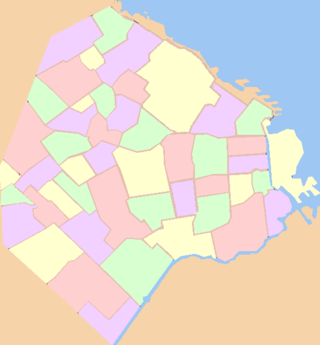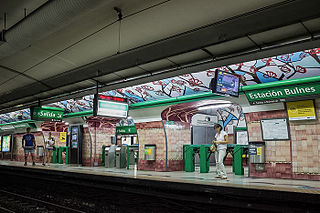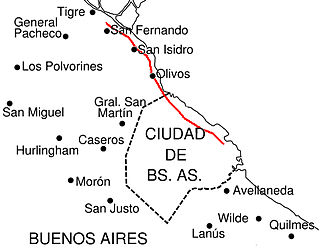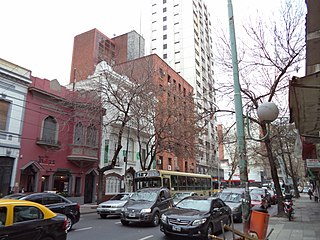
Florida Street is a popular shopping street in Downtown Buenos Aires, Argentina. A pedestrian street since 1971, some stretches have been pedestrianized since 1913.

Belgrano is a northern and leafy barrio or neighborhood of Buenos Aires, Argentina.

Palermo is a barrio or neighborhood of Buenos Aires, Argentina. It is located in the north of the city, near the Rio de la Plata.

Recoleta is a barrio or neighborhood of Buenos Aires, Argentina, located in the northern part of the city, by the Río de la Plata. The area is perhaps best known to be the home of the distinguished Recoleta Cemetery. It is a traditional upper-class and conservative neighborhood with some of the priciest real estate in the city, known for Paris-style townhouses, lavish former palaces and posh boutiques.
Palermo is the principal city and administrative seat of Sicily, Italy.

Buenos Aires, autonomous city and capital of Argentina, is composed of forty-eight neighborhoods. Since 2008, the city is also legally divided into communes, each one including one or more barrios. Among the most visited and populated barrios are Palermo, Recoleta, Puerto Madero, Belgrano, San Telmo, La Boca, Monserrat and Caballito. Sectors of the city are also traditionally known as neighborhoods by the inhabitants of Buenos Aires, but not officially by the authorities of the city; some examples include Chinatown, Barrio Norte and the Microcentro.

According to the World Travel & Tourism Council (WTTC) the travel and tourism sector of Argentina was moving towards recovering its pre-covid pandemic contribution to GDP in mid-2023, led by Buenos Aires.

Parque Arauco is the third largest Chilean shopping malls company, after Cencosud's malls division and Mall Plaza the S.A.C.I. Falabella shopping malls subsidiary. It is headquartered in Santiago. The company manages shopping malls in Chile, Peru and Colombia. It has 24 shopping malls with a total of GLA 672,700 square meters.

Coronel Díaz Avenue is an avenue that marks the limit between the Palermo and Recoleta neighborhoods in Buenos Aires, Argentina, and extends northbound, parallel Pueyrredón Avenue. It starts on Soler Street and ends on Castex Street, passing along Las Heras Park and the nearby Alto Palermo Shopping Center.

Bulnes is a station on the Line D of the Buenos Aires Underground at the intersection of Avenida Santa Fe and Bulnes Street. The station was opened on 23 February 1940 as part of the extension of Line D from Tribunales to Palermo.

Avenida del Libertador is one of the principal thoroughfares in Buenos Aires, Argentina, and in points north, extending 25 km (16 mi) from the Retiro District of Buenos Aires to the northern suburb of San Fernando.

Avenida Santa Fe is one of the principal thoroughfares in Buenos Aires, Argentina. The artery is essential to the imaginary axis of Barrio Norte in Buenos Aires, comprising the areas influenced by the route of the avenue through Retiro, Recoleta and Palermo neighborhoods, it is considered one of the main shopping and strolling areas of the city, its many boutiques range from elegant to edgy, which has led it to be dubbed the 'Avenue of Fashion'. Upscale Alto Palermo, at Avenida Coronel Díaz, is one of the city's best-known vertical malls. Avenida Santa Fe is also an attraction for its architecture, strongly reminiscent of Paris. Its name pays homage to the eponymous province in Argentina.

Patio Bullrich is a shopping center located in the Retiro neighborhood of Buenos Aires, Argentina. The building was originally an auction house owned by the Bullrich family, where cattle and pieces of art were auctioned. The then-disused house was refurbished by Grupo IRSA, preserving its original architecture and elements. Under the name "Patio Bullrich", the mall was inaugurated in August 1988.

Inversiones y Representaciones Sociedad Anónima is the leading real estate development firm in Argentina. Its controlled by Cresud S.A. in a 64%.

Eduardo Sergio Elsztain is a prominent Argentine businessman who is his country's largest real-estate developer. According to The Jerusalem Post, Elsztain "stands atop Argentina's largest business empire, the country's leader in real estate and agriculture, which he built with his own two hands."

Easy Hogar y Construcción is a chain of South American homecenters. The company was founded in Argentina in 1993, in Chile in 1994 and in Colombia in 2007, by Chilean Conglomerate Cencosud.

Avenida Medrano is an arterial road in Buenos Aires, Argentina. It was named after the politician Pedro Medrano. It runs through both the Almagro and Palermo neighborhoods. The arterial road runs northbound, with traffic going in the opposite direction. The avenue is characterized by its old banana grove, which was planted at the end of the 19th century. The trees protect the road from the sun during summer and are left completely bare after fall and during winter.

The Faculty of Economic Sciences, also simply known as Económicas, is a faculty of the University of Buenos Aires (UBA), the largest university in Argentina. Established in 1913 as the Instituto de Altos Estudios Comerciales, it is now the largest faculty within UBA, with over 36,000 grad students. The Faculty of Economic Sciences has the highest rate of international postgraduate students at 30 percent, in line with its reputation as a "top business school with significant international influence."

Dot Baires Shopping is a shopping center located in the Saavedra neighborhood of the city of Buenos Aires, Argentina. The mall was opened in 2009 incorporating an office building into the complex, plus architecture with a dynamic, highly visible front and a landscaped atrium on Avenida General Paz.






















